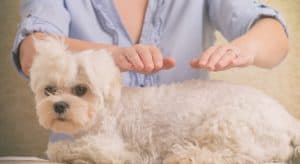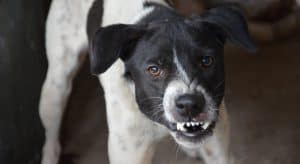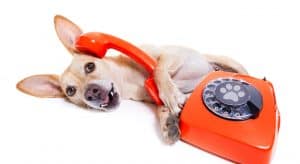Destructive dog chewing at its worst can result in the destruction of prized possessions and even damage the relationship you have with your dog. It can cause upset, anger, and frustration for all sides. As dog owners, we all know that most dogs enjoy a good chew as chewing is part of a dog’s DNA! However, when the chewing becomes overly aggressive resulting in destruction where nothing is safe around your dog or it gets chewed then you know you have a canine behavioral problem that needs to be addressed.
Finding a way to prevent this type of destructive canine behavior should be a top priority but first, we need to look at the reasons dogs chew in the first place, and then we have the 7 steps to prevent destructive dog chewing.
Why Do Dogs Chew?
1. Natural Behavior
It’s part of a dog’s natural instinct and drive to chew. Chewing for a dog is a way of relaxing and chilling out. It’s a fun activity and so long as your dog is chewing an acceptable item like a bully stick or chew toy then that’s fine.
2. Teething
Puppies will chew almost anything when they are teething. It can be quite painful when a puppy’s adult teeth start to push through. The gums can become inflamed and the puppy will chew on items for pain relief and soothe any discomfort.
During the teething process, puppies experience discomfort and pain as the adult teeth push through the gums. You may even notice some small blood stains on the puppy’s chew toys and this is quite common to see during this period. Puppies will chew so as to provide some pain relief. As the puppy grows into adolescence those new adult teeth are growing and developing and this can cause the teenage pup to chew things for relief. You will need to ensure there are adequate chew toys available and boundaries are set as to what is allowed to be chewed.
3. Outlet for Emotions
Oftentimes a dog will resort to chewing when boredom or anxiety sets in. As dogs are such sociable creatures they can become anxious and lonely when they are left alone. Chewing provides them with an outlet to express their emotions. It soothes and calms the dog – sorta like comfort food. In a similar way, many humans will bite their nails when they are anxious or nervous about something.
4. Pent Up Energy
When a dog does not receive an adequate amount of exercise he will most likely have some pent-up energy that needs an outlet. Chewing gives your dog the channel to release this energy and it gives him something to do.
7 Steps To Prevent Destructive Dog Chewing
There are several steps you can take to prevent destructive dog chewing and they include the following:
1. Puppy-Proof Your Home
The best thing you can do is to take control of the situation yourself by puppy-proofing the home. Do not leave any tempting chewable items in your dog’s path. Even the most obedient and angelic dog could be tempted to chew a lovely tasty new leather shoe. From your dog’s perspective – “It smells so good and just a little chew won’t do any harm.”
You will need to ask yourself several questions including:
- Is your dog athletic and agile to jump and climb?
- Can your dog jump onto something to reach the desired item?
- How tall is your dog when standing upright on his hind legs?
Some of the most common targets for aggressive dog chewers include:
Shoes, cell phones, remote controls, books, bags, glasses!
If you have an aggressive dog chewer You will need to confine your dog to a certain part of the house where access to these items is restricted. One of my dogs used to go the bathroom and steal toilet rolls and have lots of fun chewing and ripping toilet paper everywhere
In addition, make sure there are no food items about as dogs have better noses than us and can detect some tasty items on high counters. The best thing you can do is to avoid placing temptation in your dog’s way. As the famous playwright, Oscar Wilde said: “I can avoid everything except temptation.”
2. Provide Plenty of Chewing Options
By providing plenty of chewing options for your dog it will help reduce the likelihood that your items will be chewed. Many dogs enjoy a good chew especially puppies and young adolescent dogs so make sure they have a selection of toys available that can be chewed. Give them a few items to play with at a time and rotate the selection every few days to prevent boredom. If your dog is well behaved you and you are looking to reward them you could try a natural chewing treat like a bully stick. This can help pass the time.
3. Don’t Let Your Dog Start in First Place
If you have a young puppy try from the outset not to let him experience the joys of chewing something he should not have. He will then never know the joys of chewing furniture, shoes, etc. The more times he gets away with chewing furniture or forbidden items the greater likelihood this behavior will continue.
4. No Blurred Boundaries
There should be no blurred boundaries between your items and your dog’s items. From the outset make it clear there should be no chewing of your possessions. Never offer your dog an old pair of shoes, old clothes, towels, etc to chew. It will only send mixed messages and confuse your dog. How is he to know that your new shoes are not for chewing either? They smell like the old ones and from your dog’s perspective they look the same. I don’t think dogs are into fashion trends or able to distinguish.
5. Active Supervision
Rather than crating or confining your dog to a chew-free zone, you can actively supervise him to ensure that forbidden items should not be chewed. He will have to learn the house rules of what can and cannot be chewed. With your active supervision and plenty of chew toys on hand for distraction, he will learn much quicker than if confined on his own in a crate. Dogs are naturally inquisitive and will need the freedom to explore and learn the ropes.
6. Caught In The Act
If you catch your dog chewing an item that should be off-limits then immediately make a sound like clapping your hands to interrupt the chewing. Do not make a sound that is too loud as it will only frighten your dog. After you clap your hands you then need to say “No” in a deep a voice as possible to show disapproval. Then immediately grab one of your dog’s chewing toys or a tasty chewing option. Walk to your dog and take the other item from his mouth and replace it with your option. Then it is a matter of praise.
Remember dogs respond to pitch tone so in a higher pitch voice offer lots of praise. This will help your dog to learn that his items are good for a chew whereas your items are not.
7. Be Patient & Remain Positive
Dog training takes plenty of patience and it can take longer for some dogs to learn. It’s all part of the package of being a dog owner. Every dog is different and that’s what makes them great. They all have unique personalities.
Consequently dogs just like humans are not perfect and there will be occasions where accidents can happen. As time progresses your dog will learn but undoubtedly there will be mistakes on both sides. It’s bound to happen that some prized item will end up chewed. Just try and take precautions to prevent it from happening until your dog is fully acquainted with all the house rules and that includes not eating your items. Don’t place temptation in the way of a puppy who is eager to chew.
.
Further Information
For further information on dog training techniques and to learn how to deal with dog behavioral problems like destructive dog chewing then check out the Secrets to Dog Training. It’s the complete manual for dog ownership and is designed to fast-track your dog’s learning.







